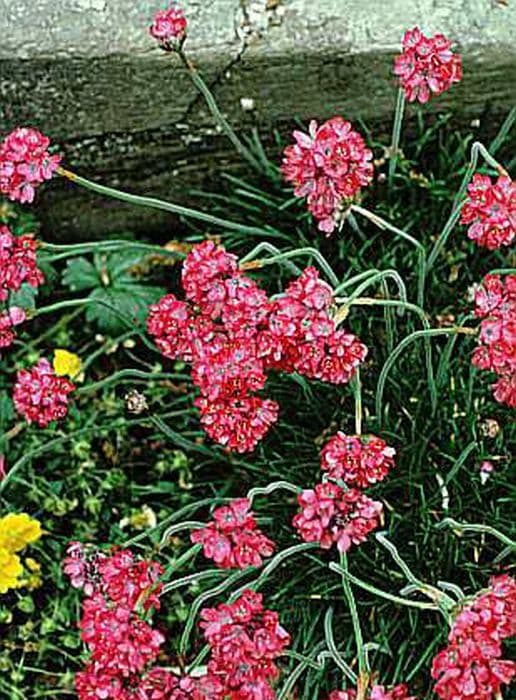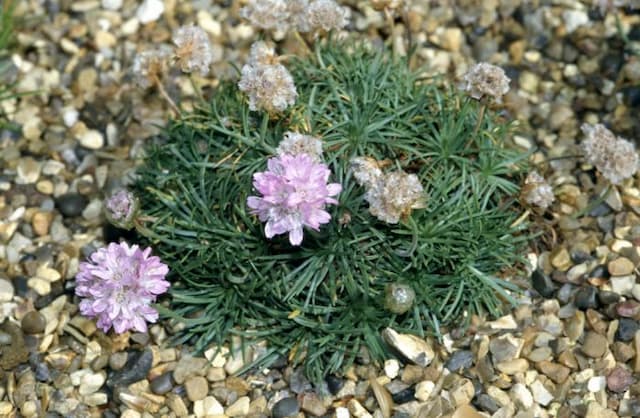Thrift Armeria maritima 'Vindictive'

ABOUT
The common name for Armeria maritima 'Vindictive' is the Sea Thrift or Sea Pink. This plant is known for its tufted evergreen nature, forming a dense, cushion-like mound. The leaves are narrow, grass-like, and a deep green color, which creates a fine-textured low clump. The main attraction of the Sea Thrift is its flowers. They bloom profusely in round clusters on top of wiry stems that rise well above the foliage. Each flower cluster is comprised of many small individual blooms that are usually a vivid pink or rose-pink hue, giving the plant a very striking appearance when in full bloom. The overall effect of the Sea Thrift is a splash of color and form that is reminiscent of a delicate, flowering cushion on the landscape.
About this plant
 Names
NamesFamily
Plumbaginaceae.
Synonyms
Sea Thrift, Sea Pink, Thrift, Cliff Rose, Lady's Cushion, Cushion Pink, Marsh Daisy, Sea Gilliflower.
Common names
Armeria maritima 'Vindictive'.
 Toxicity
ToxicityTo humans
Armeria maritima, commonly known as thrift, is not widely recognized as a toxic plant to humans. There is limited information on the specific cultivar 'Vindictive', but generally, thrift is considered non-toxic. However, it's always advisable to exercise caution and avoid ingesting parts of ornamental plants as they are not intended for consumption. In the absence of documented toxicity, specific symptoms of poisoning from ingestion of Armeria maritima 'Vindictive' are not expected.
To pets
Thrift (Armeria maritima) is not known to be toxic to pets either. As with humans, there is little information on the specific 'Vindictive' cultivar, but generally, thrift is not associated with poisoning in animals. Thus, no specific symptoms of poisoning are expected. Nevertheless, it is always wise to prevent pets from ingesting plants not meant for consumption, as individual animals might have unique sensitivities or allergic reactions.
 Characteristics
CharacteristicsLife cycle
Perennials
Foliage type
Evergreen
Color of leaves
Green
Flower color
Pink
Height
0.5 feet (15 cm)
Spread
1 feet (30 cm)
Plant type
Herb
Hardiness zones
4
Native area
Europe
Benefits
 General Benefits
General Benefits- Low Maintenance: Armeria maritima 'Vindictive', also known as thrift, is known for being easy to care for, requiring minimal upkeep.
- Drought Tolerance: Once established, thrift is quite drought-resistant, making it an excellent choice for water-wise gardens.
- Soil Adaptability: Thrift can adapt to a range of soil types, though it prefers well-drained soils.
- Attracts Pollinators: The blooms of thrift attract bees and butterflies, providing food for these beneficial insects.
- Salt Tolerance: As its common name suggests, thrift is tolerant of salty soil conditions, often found naturally on sea cliffs and coastal areas.
- Ornamental Appeal: With its grassy foliage and round pink or white flower heads, thrift adds visual interest to gardens and landscapes.
- Edge Planting: Due to its compact nature, thrift is excellent for edges, borders, and as ground cover, providing clear lines and structure.
- Seasonal Interest: Thrift blooms from late spring to early summer, offering seasonal splashes of color when many other plants are not yet flowering.
- Erosion Control: The tufted growth habit of thrift helps stabilize soil and protect against erosion.
- Rock Gardens: It's well-suited for rock gardens due to its size and the fact that it thrives in well-drained conditions.
 Medical Properties
Medical PropertiesThis plant is not used for medical purposes.
 Air-purifying Qualities
Air-purifying QualitiesThis plant is not specifically known for air purifying qualities.
 Other Uses
Other Uses- Sea thrift, the common name for Armeria maritima 'Vindictive', can be used as a natural dye for fabrics, providing a range of subtle earth tones.
- Artists may use sea thrift for crafting eco-friendly plant-based ink for drawing or calligraphy, capitalizing on its unique pigmentation.
- The plant can be utilized in miniature fairy gardens due to its small, rounded shape, adding a whimsical touch to these creative displays.
- Sea thrift can serve as an edible garnish for culinary presentations, offering a fresh, salty flavor reminiscent of the sea.
- The dried flower heads of sea thrift can be used in dried flower arrangements, maintaining their shape and color for extended periods.
- A component in creating natural potpourri, sea thrift’s vibrant blooms add color, while its leaves can contribute a subtle scent.
- The dense cushion-like growth habit of sea thrift can be used in green roofing, providing insulation and aiding in stormwater management.
- This plant can be a subject for botanical illustration, providing an interesting form and texture for artists who specialize in plant drawings.
- Sea thrift can be used in coastal erosion control projects, as it can stabilize soil with its deep root system.
- The flowers can be pressed and utilized in crafts such as homemade cards, bookmarks, or as a decorative element in scrapbooking.
Interesting Facts
 Feng Shui
Feng ShuiThe plant Thrift is not used in Feng Shui practice.
 Zodiac Sign Compitability
Zodiac Sign CompitabilityThe plant Thrift is not used in astrology practice.
 Plant Symbolism
Plant Symbolism- Survival: Commonly known as Sea Thrift or Thrift Plant, Armeria maritima often symbolizes survival due to its ability to thrive in harsh coastal conditions.
- Perseverance: The plant's propensity to grow in rocky, sandy soils has made it a symbol of perseverance and the ability to endure challenging environments.
- Adaptability: Sea Thrift's capacity to adapt to salty, high-wind areas represents adaptability and flexibility in life.
- Conservation: Often found in nature reserves and protected areas, it symbolizes the importance of conservation and environmental awareness.
- Beauty: With its colorful pom-pom-like flowers, Sea Thrift signifies natural beauty and the simplicity of wildlife aesthetics.
 Water
WaterThrift, or sea pink, prefers well-drained soil and does not tolerate standing water, so it's crucial to water it sparsely. Typically, watering thrift once a week with about one gallon of water is adequate; however, this can vary depending on climate and soil conditions. During the summer or in hotter climates, monitor the soil moisture and increase watering to twice a week if needed. Over the winter, reduce watering significantly and only water if the soil is completely dry, as the plant is quite drought tolerant once established.
 Light
LightThrift thrives in full sunlight, benefiting from a minimum of six hours of direct sun each day. The best spot for this plant would be in an area where it can receive ample morning and afternoon sunlight. Partial shade is acceptable, especially in regions with extremely hot summers, but flowering may be reduced.
 Temperature
TemperatureThrift is hardy and can tolerate a wide temperature range, surviving in temperatures as low as 0°F and as high as 80°F. Still, the ideal temperature range for this plant is between 40°F and 75°F. Make sure the plant is situated in a location where temperatures do not frequently drop below freezing for extended periods.
 Pruning
PruningPruning thrift is essential to maintain its compact shape and to promote dense, vibrant flowering. Remove spent flower stems and shear back foliage after the first bloom to encourage a second flush of flowers. Pruning is best done in early spring or late summer after flowering has finished for the season.
 Cleaning
CleaningAs needed
 Soil
SoilThrift, commonly known as Sea Thrift, thrives in well-draining sandy or loamy soil with good aeration. The best soil mix for Sea Thrift would consist of equal parts garden soil, sand, and peat or compost to ensure proper drainage and nutrient availability. This plant prefers a slightly acidic to neutral pH ranging from 5.5 to 7.0.
 Repotting
RepottingSea Thrift does not require frequent repotting and should generally be repotted every two to three years to refresh the soil and accommodate root growth. This allows the plant to continue thriving without becoming root-bound.
 Humidity & Misting
Humidity & MistingSea Thrift is adaptable to a wide range of humidity levels and typically does well in the average humidity found in outdoor environments. It does not require high humidity to thrive, making it suitable for various garden settings.
 Suitable locations
Suitable locationsIndoor
Ensure bright light, well-drained soil, and periodic watering for indoor Sea Thrift care.
Outdoor
Plant in full sun, well-draining soil, and water regularly for outdoor Sea Thrift.
Hardiness zone
4-8 USDA
 Life cycle
Life cycleArmeria maritima 'Vindictive', commonly known as Thrift or Sea Pink, begins its life cycle as a seed, which, once germinated in early spring, develops into a small seedling with narrow, grass-like leaves. The seedling stage transitions into vegetative growth, establishing a tufted mound of evergreen foliage that can withstand poor soil and harsh, coastal conditions. As it matures, usually in its second year, the plant produces sturdy stems topped with globular flower heads, ranging from pink to violet, and blooms from late spring to early summer. Post-blooming, the flowers fade and develop into capsules containing seeds, which are then dispersed by wind, water, or wildlife, facilitating the spread of the plant to suitable new habitats. After the flowering period, the plant enters a period of dormancy during late fall and winter, conserving energy for the next growing season. This perennial plant can live several years, repeating this cycle and expanding through vegetative propagation if the conditions are favorable.
 Propogation
PropogationPropogation time
Spring to Summer
Propogation: Armeria maritima 'Vindictive', commonly known as Thrift or Sea Pink, is best propagated through division. This method is favored for its simplicity and effectiveness. The ideal time for division is in the spring or early fall when the plant is not in active bloom. To propagate by division, carefully dig up an established clump of Thrift, ensuring a generous amount of root is attached. Gently pull or cut the clump into smaller sections, each with several shoots and a portion of the root system. These divisions can then be immediately replanted in well-draining soil, spaced approximately 6 to 12 inches (15 to 30 centimeters) apart to allow room for growth. Water the new divisions thoroughly to help establish the root system.




